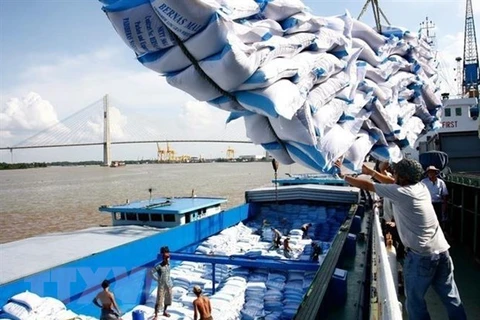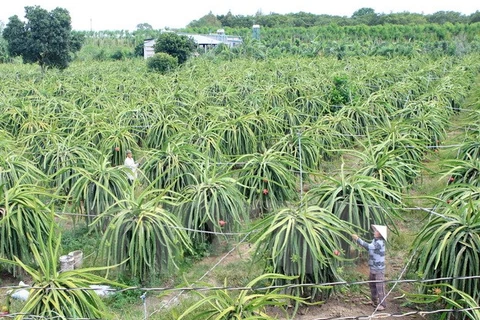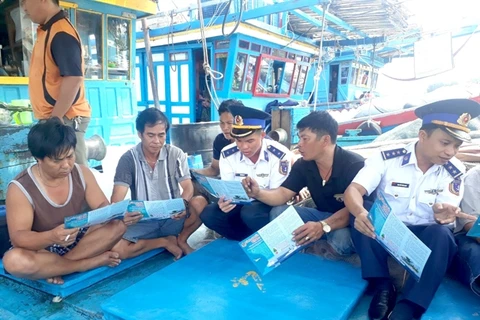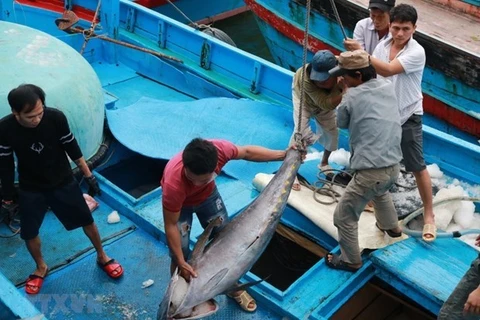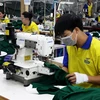Hanoi (VNS/VNA) - The COVID-19 pandemic could provide a good opportunity for the Vietnamese fisheries sector to increase its share in oversea markets, especially with foreign rivals engulfed by lockdowns or other forms of restrictions, experts have said.
Braving certain difficulties, fishery exports had shown signs of recovery with export orders rising more than 10 percent recently, according to the Ministry of Agriculture and Rural Development (MARD).
State management agencies and seafood exporters both predict better business prospects in the last three months as the demand for fishery products post-pandemic in both domestic and overseas markets will increase sharply.
Ngo Tuong Lan, deputy secretary general of the Vietnam Association of Seafood Exporters and Producers (VASEP), said COVID-19 was an opportunity for the domestic fishery industry to adapt and develop.
Vietnam’s rivals such as India, Indonesia and Ecuador are under lockdown and quarantines to combat the pandemic, which has driven their production and exports down by 30-50 percent.
“This is a great opportunity for Vietnamese seafood exporters to increase their market shares,” Lan told a recent conference on promoting seafood production and consumption.
Particularly, the EU-Vietnam Free Trade Agreement (EVFTA) will open doors to the EU, along with a recovery in other important markets like China, Japan and the United States.
Under the EVFTA, about 220 fishery products will enjoy tariff lines ranging from zero to 22 percent, most of the high tax lines of 6-22 percent will be reduced to zero percent immediately after the agreement takes effect and the remaining tax lines will be phased out after 3-7 years.
According to Lan, tra (pangasisu) fish – one of Vietnam’s staples – faced many difficulties, with production output and exports declining by nearly 30 percent, so solution were needed to recover exports. Meanwhile, shrimp had maintained stable production and shown signs of rebound.
The five main export markets for Vietnamese shrimp are the US, Japan, China, the EU and the Republic of Korea. The US and the RoK had continued to maintain positive growth of 32 percent and 8.5 percent, respectively.
Earlier this month, 12 Vietnamese enterprises were given permission to re-export some seafood products to the Saudi Arabia market after nearly three years of a temporary suspension order.
However, in order to take advantage of new opportunities, MARD’s specialised agencies recommended both farmers and exporters improve quality and ensure food safety in all stages from farming to seafood exploitation and processing.
The National Agro-Forestry-Fisheries Quality Assurance Department has updated and sent out the new regulations, quality control systems and food safety for products that meet the requirements of importing markets such as the EU, China and the RoK.
Deputy Minister of Agriculture and Rural Development Phung Duc Tien said in anticipation of the free trade deal, Vietnamese fishery enterprises had made necessary preparations to meet the requirements of the EVFTA.
He added that Vietnam was also mobilising the entire political system to address the problem of illegal, unreported and unregulated (IUU) fishing in order to have the EU’s “yellow card” removed.
The country’s fishery exports reached 5.6 billion USD by mid-September, while the industry is striving for total export turnover of 8.9 billion USD this year./.
Braving certain difficulties, fishery exports had shown signs of recovery with export orders rising more than 10 percent recently, according to the Ministry of Agriculture and Rural Development (MARD).
State management agencies and seafood exporters both predict better business prospects in the last three months as the demand for fishery products post-pandemic in both domestic and overseas markets will increase sharply.
Ngo Tuong Lan, deputy secretary general of the Vietnam Association of Seafood Exporters and Producers (VASEP), said COVID-19 was an opportunity for the domestic fishery industry to adapt and develop.
Vietnam’s rivals such as India, Indonesia and Ecuador are under lockdown and quarantines to combat the pandemic, which has driven their production and exports down by 30-50 percent.
“This is a great opportunity for Vietnamese seafood exporters to increase their market shares,” Lan told a recent conference on promoting seafood production and consumption.
Particularly, the EU-Vietnam Free Trade Agreement (EVFTA) will open doors to the EU, along with a recovery in other important markets like China, Japan and the United States.
Under the EVFTA, about 220 fishery products will enjoy tariff lines ranging from zero to 22 percent, most of the high tax lines of 6-22 percent will be reduced to zero percent immediately after the agreement takes effect and the remaining tax lines will be phased out after 3-7 years.
According to Lan, tra (pangasisu) fish – one of Vietnam’s staples – faced many difficulties, with production output and exports declining by nearly 30 percent, so solution were needed to recover exports. Meanwhile, shrimp had maintained stable production and shown signs of rebound.
The five main export markets for Vietnamese shrimp are the US, Japan, China, the EU and the Republic of Korea. The US and the RoK had continued to maintain positive growth of 32 percent and 8.5 percent, respectively.
Earlier this month, 12 Vietnamese enterprises were given permission to re-export some seafood products to the Saudi Arabia market after nearly three years of a temporary suspension order.
However, in order to take advantage of new opportunities, MARD’s specialised agencies recommended both farmers and exporters improve quality and ensure food safety in all stages from farming to seafood exploitation and processing.
The National Agro-Forestry-Fisheries Quality Assurance Department has updated and sent out the new regulations, quality control systems and food safety for products that meet the requirements of importing markets such as the EU, China and the RoK.
Deputy Minister of Agriculture and Rural Development Phung Duc Tien said in anticipation of the free trade deal, Vietnamese fishery enterprises had made necessary preparations to meet the requirements of the EVFTA.
He added that Vietnam was also mobilising the entire political system to address the problem of illegal, unreported and unregulated (IUU) fishing in order to have the EU’s “yellow card” removed.
The country’s fishery exports reached 5.6 billion USD by mid-September, while the industry is striving for total export turnover of 8.9 billion USD this year./.
VNA

